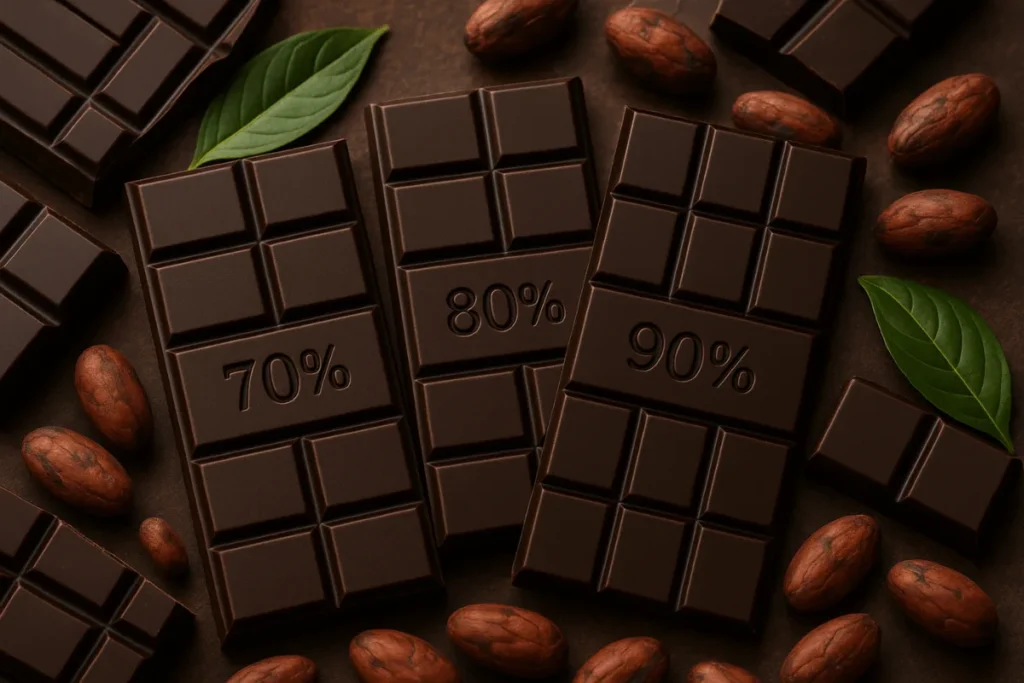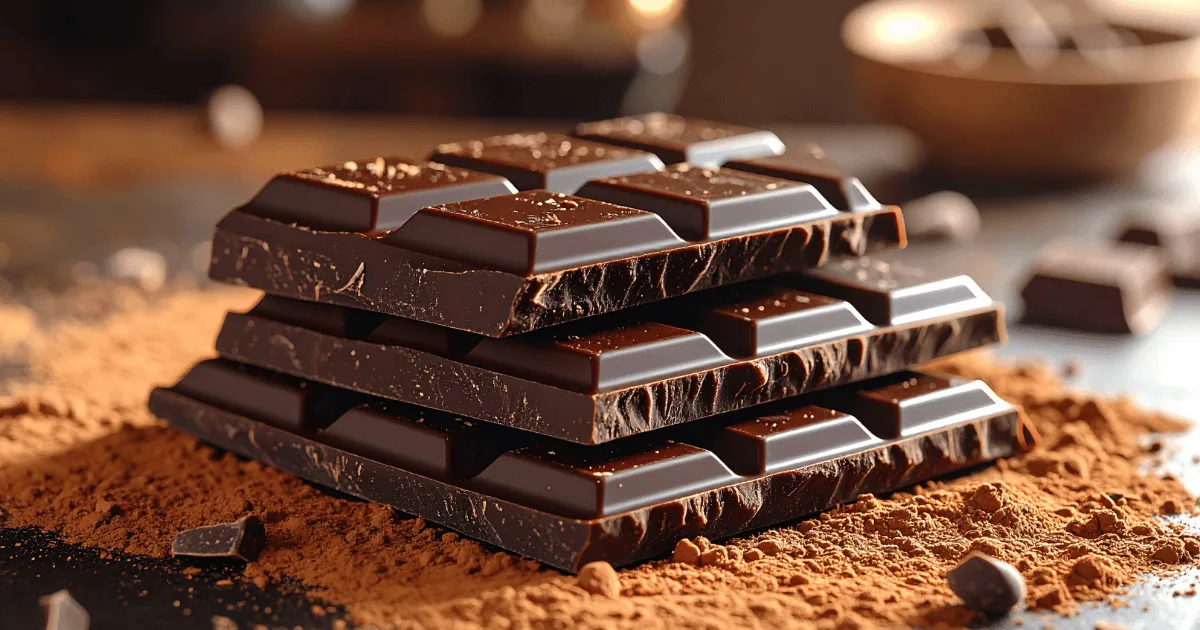When you think of dark chocolate, you probably picture a smooth, slightly bitter square melting on your tongue… not a secret weapon for powering through your day. But guess what? That same treat you snack on during a Netflix binge can keep your brain sharp, your mood happy, and your body buzzing with energy — without that dreaded sugar crash.
Now, we’re not talking about the random “chocolate” bar from the gas station. Nope. We mean the real deal — high-cocoa dark chocolate that’s rich, intense, and full of good-for-you stuff. Pick the right kind, enjoy it in moderation, and it can earn a spot on your healthy snack list.
So grab a square (70% cocoa or higher), and let’s dig into the 9 ways dark chocolate can give you an energy boost — with a side of foodie wisdom and maybe a little drool.
Table of Contents
Dark Chocolate and Energy: 9 Powerful Benefits You’ll Love
1. Nutritional Powerhouse for Long-Lasting Energy
Good dark chocolate isn’t just a sweet treat — it’s a sneaky health bar in disguise. It is filled with minerals essential for your body to produce energy.
A 50g bar of top-tier dark chocolate with a cocoa content of 70–85% comprises:
- Iron – helps your muscles and brain get the oxygen they need
- Magnesium – keeps your energy production on point and muscles happy
- Copper – boosts your metabolism
- Manganese – supports your bones and helps fight cell damage
You’ll also get potassium, zinc, selenium, and healthy fats from cocoa butter — the kind that gives you slow, steady fuel instead of a sugar spike and crash. Plus, it’s got fiber to keep that energy drip-feeding into your system.
2. Antioxidants = Tiny Bodyguards for Your Cells
Your body runs better when your cells are happy, and dark chocolate is loaded with antioxidants like flavonoids and polyphenols. These guys fight off free radicals (a.k.a. the troublemakers that drain your energy and age your cells).
Think of it like this: the antioxidants in chocolate are little bouncers for your mitochondria — your body’s energy factories — keeping them safe so they can keep cranking out power.

3. Better Blood Flow = Better Brain Power
Feeling foggy? By helping your body produce nitric oxide, dark chocolate relaxes blood vessels and boosts circulation. More blood flow = more oxygen and nutrients for your brain and muscles.
Bonus perks backed by studies:
- Boosts memory and focus in young adults
- Supports thinking skills in older adults
- Gives you a quick mental lift thanks to theobromine and a touch of caffeine
4. Happy Heart, Happy Energy Levels
If your heart’s pumping strong, your whole body works better. Dark chocolate can:
- Lower bad cholesterol
- Raise good cholesterol
- Keep blood vessels flexible
People who eat chocolate a few times a week have a lower risk of heart disease — so yes, your favorite square of Lindt or Hu might help you go the distance.
5. Keeps Your Blood Sugar Nice and Steady
Energy crashes usually happen when your blood sugar spikes and drops. Dark chocolate, especially varieties with 85% cocoa or more, is low in sugar and high in fiber, contributing to stability.
Studies even link it to a lower risk of type 2 diabetes — meaning more consistent energy, fewer rollercoaster moments.
6. Puts You in a Great Mood (Which Feeds Your Energy)
It is edible happiness. It triggers:
- Endorphins (feel-good vibes)
- Serotonin (mood stabilizer)
- Dopamine (focus + reward center)
When you’re in a good mood, you naturally feel more energized. Proof that sometimes the best pick-me-up is chocolate.
7. Secret Weapon Before a Workout
Need a little pre-gym motivation? Dark chocolate’s caffeine, theobromine, and magnesium can help you push harder, last longer, and even feel like your workout is less of a grind.
Some athletes sip on a dark cocoa drink before training — not a bad idea if you want an extra edge (and a tastier warm-up than black coffee).

8. Keeps Your Skin Looking Fresh While You Hustle
Okay, so glowing skin doesn’t directly boost energy, but it’s part of feeling great. Dark chocolate’s flavanols help protect against sun damage, improve hydration, and make your skin feel smoother.
One study showed that high-flavanol cocoa boosted sun protection after 12 weeks. Still, don’t forget your sunscreen since chocolate isn’t a magical fix.
9. How to Pick the Good Stuff
All these benefits only count if you choose the real deal. Look for:
- 70% cocoa or higher
- Brief list of ingredients: cocoa, cocoa butter, sugar, possibly vanilla
- Labels like “bean-to-bar,” “single origin,” or “fair trade”
- Brands that care about ethical sourcing
Some favorites worth trying: Hu Chocolate, Theo Pure 70%, Equal Exchange, Madecasse Madagascar Sea Salt & Nibs.
Fun Ways to Enjoy Dark Chocolate for Energy
Chocolate Cherry Smoothie
- 1–2 pieces of this chocolate (or 1 tablespoon of cocoa powder)
- 1 cup frozen cherries
- 1 cup milk or plant milk
- 1 scoop protein powder (optional)
- Ice
Combine everything for a quick boost in mood and energy.
Other tasty ideas:
- Melt into oatmeal for a breakfast treat
- Add cocoa powder to coffee for a DIY mocha.
- Pair with almonds for a quick, portable snack
- Make a low-sugar hot cocoa before workouts

Final Bite
Dark chocolate isn’t just a dessert. It’s a power snack in disguise. Packed with nutrients and a slow-burning energy boost, it’s like your brain and body’s secret weapon.
Better focus? Check. Happier mood? Yes, your heart and blood sugar are given some care as well. Honestly, it’s one of the few healthy treats that doesn’t taste like cardboard.
Here’s the thing: chocolate isn’t all made equally. Go for the good stuff—high cocoa content, fair trade, and minimally processed. And yeah, no need to demolish the whole bar (though we’ve all been there). A couple of squares? Perfect.
So next time you’re crashing at 3 PM, skip the jittery energy drink and grab some dark chocolate instead. Trust us—your brain, body, and taste buds will be doing a victory dance.
FAQ
What’s so special about 92% dark chocolate?
Whoa, you’re going for the gold! 92% is amazing because it’s almost pure cocoa. This implies a high amount of antioxidants and minerals with minimal sugar content. It’s a powerful health boost, but be ready—it’s intense!
What even is cocoa in dark chocolate?
It’s the good stuff from the cacao bean—the solids and the cocoa butter. The key difference is that dark chocolate has a high percentage of this stuff and little to no milk, unlike milk chocolate.
So… I can eat chocolate every day?
Totally! The secret is to relish it in moderation.. A piece or two daily is ideal. Just remember it’s still got calories, so don’t go eating the whole bar in one sitting (even though it’s tempting).
How do I know if it’s REAL dark chocolate?
Easy—check the label. Short ingredient list, high cocoa percentage (70%+), and cacao listed first. Real dark chocolate has a rich, complex taste, not just sugary sweetness.
Okay, so which brand is the best?
Honestly, it’s all about what you like! Brands like Lindt (the 85% or 90% bars are great), Equal Exchange, or Theo are usually solid choices you can find pretty easily. Just experiment and find your favorite!


I always knew dark chocolate was tasty, but I didn’t realize it could actually help with energy too. Super interesting!
Dark chocolate is more than just a sweet treat—it’s packed with benefits that give you that natural energy boost. Glad you enjoyed it!
W0000w, I had no idea dark chocolate had so many energy-boosting benefits! Definitely makes me feel better about my daily chocolate habit
Right? Dark chocolate is the sweetest excuse for a healthy energy boost! 😍 Glad you found it helpful—your daily habit is officially justified!
Right? Dark chocolate is the sweetest excuse for a healthy energy boost! Glad you found it helpful—your daily habit is officially justified!
How much should you eat for energy?
A small square or two is enough. It has caffeine and theobromine for a steady boost without the crash of coffee.